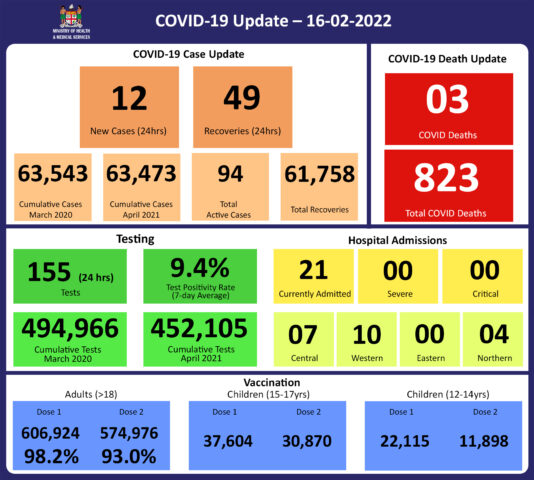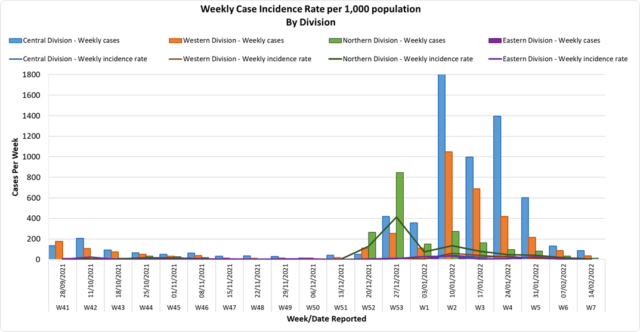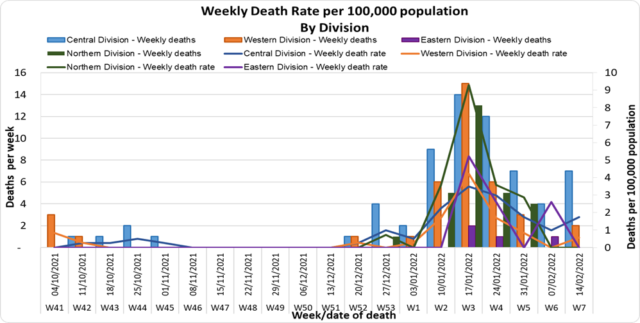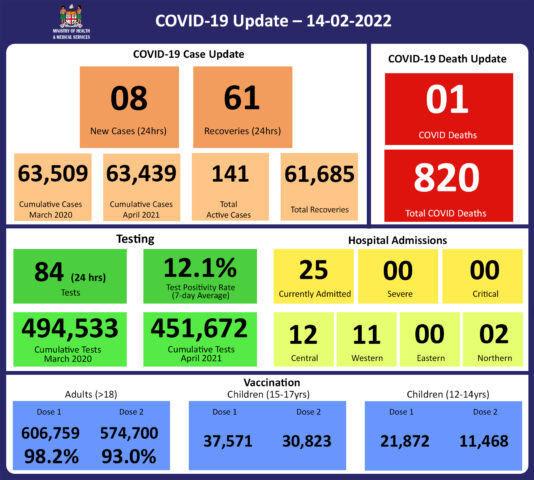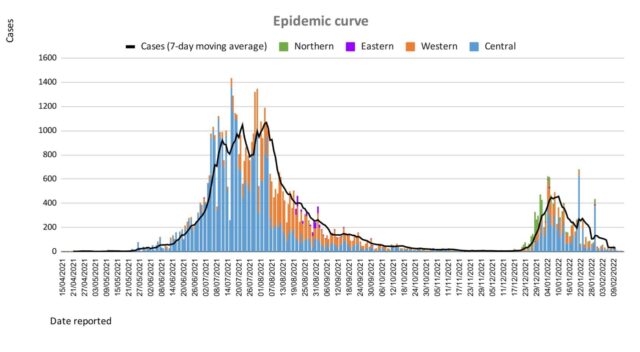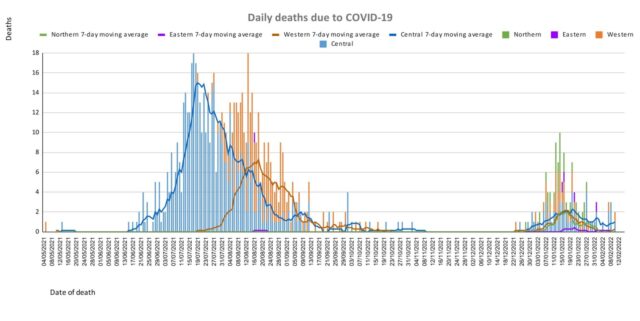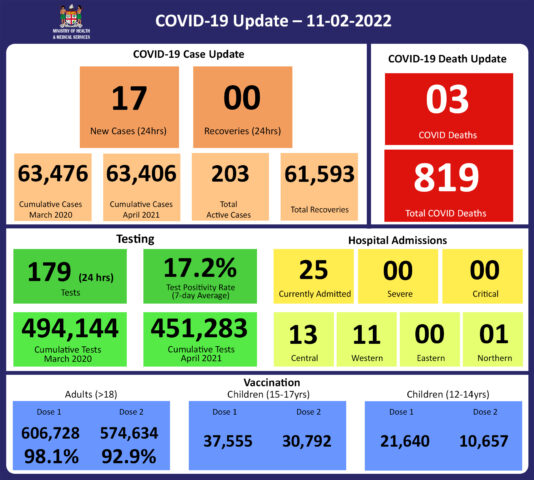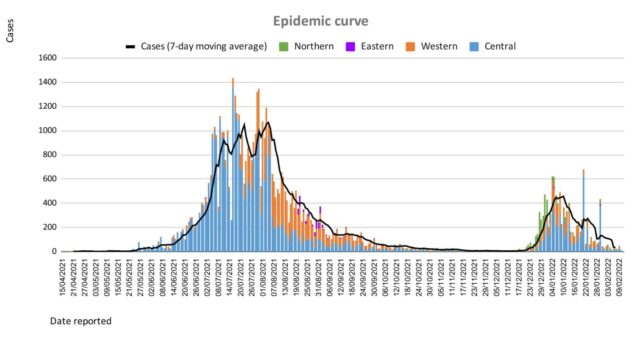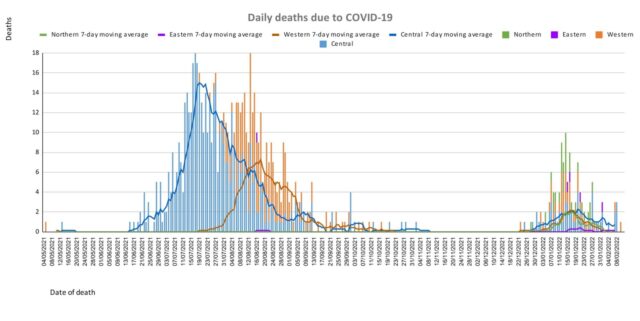COVID-19 Situation Update
Wednesday 16th February
| Transmission Update:
Since the last update, we have recorded 28 new cases of which 16 new cases were recorded on 15/02/2022 and 12 new cases in the last 24 hours ending at 8 am this morning. Of the 28 cases recorded, 11 cases were recorded in the Central Division; 13 cases were recorded in the Western Division, 4 cases were recorded in the Northern Division, and nil case was recorded in the Eastern Division. The national 7-day rolling average of cases as of 12th February is 24 daily cases. In the 7 days until 15/02/2022, 72 new cases were recorded in the Central division, 34 new cases in the Western division, 3 new cases in the Eastern Division, and 7 new cases in the Northern Division. The Central Division cases constitute 68% of the cumulative total cases nationally, with the Western division making up 28%, 3% in the Northern Division, and 1% in the Eastern Division. |
||||||||||||||||||||||||||||||||||||||||||||||||||||||||||||||||||||
| Deaths:
The curves depict weekly COVID-19 deaths by division since May 2021. It indicates a surge from December-end 2021, which peaks by mid-January 2022. The 3rd COVID 19 wave is considered to have started around mid to late December 2021. (Note: Death notifications from the weeks 27/01/22 onwards are still being received, we are currently on week 14/02/2022, therefore the appearance of a downward trend on the graph from week 27/01/22 may not be accurate. There are deaths from the Western Division currently under investigation for the same period hence, the death rate for the division may increase). Analysis of Deaths in the Third Wave Table 1: Death rates by Division
An analysis of the 127 deaths recorded in the third wave show that, while the Central Division has the highest absolute number of deaths, the Northern Division has the highest rate of death when adjusted for population. (Note: There are deaths currently being investigated from the Western Division for the same period, therefore the rate for the division may increase). Table 2: Deaths by Age Group
Table 3: Deaths by Vaccination Status
Out of 127 COVID -19 deaths reported in the third wave, five (5) deaths were in the population not eligible for vaccination (under age 12). An analysis of the 120 deaths in the vaccine-eligible population reflected, that when adjusted per 100,000 population, for fully vaccinated (received 2 doses) and unvaccinated/not fully vaccinated (received 0 doses or only 1 dose) adults in Fiji, a death rate of 8.8 per 100,000 population for fully vaccinated adults and 159.7 for unvaccinated adults was exhibited. This means that unvaccinated adults in Fiji have been dying at a rate 18.1 times higher than fully vaccinated adults during the current COVID-19 wave. Individuals of the 12-17 age group who died were not vaccinated. There have been no COVID-19 deaths in individuals who received a booster (3rd dose) of the vaccine. New deaths to report There are three new COVID-19 deaths to report from 2nd to 15th February 2022. The first COVID-19 death to report is of a 42-year-old male from the Western Division, who died at home on 02/02/2022. He was not vaccinated. The second COVID-19 death to report is of a 73-year-old female from the Central Division, who died at home on 13/02/2022. She was not vaccinated. The third COVID-19 death to report is of a 59-year-old female from the Western Division, who was admitted at Tavua Hospital on 12/02/2022. Sadly, she died on 15/02/2022 and was not vaccinated There has been a total of 823 deaths due to COVID-19 in Fiji. Please note that due to the time required by clinical teams to investigate, classify and report deaths, a 4-day interval is given to calculate the 7 days rolling average of deaths, based on the date of death, to help ensure the data collected is complete before the average is reported. Therefore, as of February 12th, 2022, the national 7 days rolling average for COVID-19 deaths per day is 1.0, with a case fatality rate of 1.29%. We have recorded 866 COVID-19 positive patients who died from other serious medical conditions unrelated to COVID-19; their doctors determined that COVID-19 did not contribute to their deaths, therefore these are not classified as COVID-19 deaths. |
||||||||||||||||||||||||||||||||||||||||||||||||||||||||||||||||||||
| Hospitalization:
There is a sustained downward trend in daily hospitalizations. Using the WHO clinical severity classification, a greater percentage, 72% (n=15) of the admissions of COVID-19 positive patients are categorised as asymptomatic and mild, 5% (n=1) are categorised as moderate and 23% (n=5) as severe with nil case in the critical category. Anyone admitted to the hospital is tested before admission, therefore, a significant number of people are admitted to the hospital for non-covid health conditions, but incidentally, test positive due to the high amount of transmission in the community. The number of people being admitted because of COVID-19 remains low. |
||||||||||||||||||||||||||||||||||||||||||||||||||||||||||||||||||||
| Testing:
155 tests have been reported for February 15th, 2022. Total cumulative tests since 2020 are 494,966 tests. The 7-day daily test average is 176 tests per day or 0.2 tests per 1,000 population. The national 7-day average daily test positivity is 9.4%. The high positivity rate is an indication of widespread community transmission. |
Public Advisory:
Leptospirosis, typhoid fever, and dengue fever
With the recent heavy rains and flooding in parts of Fiji we anticipate an increase in leptospirosis, typhoid and dengue fever, as these are climate-sensitive diseases that are endemic to Fiji.
For leptospirosis we have recorded 179 cases nationally since the beginning of the year, of which the Central division reported 65, the Eastern division 3, the Northern division reported 38, and 73 cases have been reported from the West. Case numbers are above the expected numbers for this time of the year in the West and Central Division. There is also an increasing trend noted in the North. Hospital admission and deaths data indicate that most of the hospital admissions and deaths are in the Western division. There have been 14 deaths, with 12 in the Western Division, 1 in the Central Division, and 1 in the Northern Division. The majority of hospital admissions in the Western Division are from Ba, Nadroga/Navosa, Rakiraki, and some parts of Lautoka. The majority of admissions in the Central Division have been from Serua/Namosi, Wainibokasi and Tailevu. As previously reported, delay in accessing care has been noted to contribute significantly to these adverse outcomes.
In Fiji, leptospirosis is endemic and is common in both rural and urban areas where there is exposure to the urine of animals such as rats, pigs, cows, and dogs, and where there is frequent flooding, or poor drainage, resulting in people walking through muddy ground or waters. Every year we get an increase in cases noted during the wettest months from November to April. The clinical and epidemiological data indicate that males and young adults aged 20-49 years high-risk groups, and young iTaukei males are overly represented in cases and severe outcomes. The disease however can however infect anyone as the risk is mediated by greater occupational and recreational exposure to animals, soil, mud, and water. Of particular note is the playing of sports on muddy flood-affected grounds. Other risk factors include farming, working outdoors or in abattoirs; living in households that have rats living nearby; raising pigs at home, or the presence of pigs in the community.
Members of the public must understand that to prevent leptospirosis, one should avoid wading or swimming in flooded waters, wear shoes when outside, and keep all food and drinks covered and away from rats. For workplaces the importance of controlling pests, practising good personal hygiene, using protective equipment, especially footwear when in flooded and/or muddy areas.
Early treatment can decrease the severity and duration of the disease. Please seek medical care if you have recently had contact with floodwaters, mud, or animals, and develop the following symptoms: fever, muscle pain, headache. You may also have red eyes, loss of appetite, nausea/vomiting, dizziness, or feel weak. Leptospirosis can be treated with appropriate antibiotic medications prescribed by a doctor if treatment is sought early. Danger signs for severe leptospirosis include shortness of breath, coughing blood, chest pain, yellow eyes/skin (jaundice), signs of bleeding (including unexplained bruising), decreased or increased urination, difficulty staying awake. Severe leptospirosis is life-threatening, and anyone with these symptoms must be taken to the hospital immediately.
For typhoid fever, we have reported 30 cases since the beginning of the year of which 11 were from the Central Division, 14 in the Western Division, and 5 in the North. Case numbers of typhoid fever are below the expected numbers for this time of year. Typhoid fever is typically found in areas that do not have access to clean drinking water such as rural areas and urban informal settlements. We strongly encourage people who live in these areas, and any other areas without access to clean drinking water, to boil all drinking water. We must all also continue to practise basic hygiene measures such as frequently washing hands with soap and water, but especially after visiting the toilet and before eating or preparing food.
The WASH (Water, Sanitation and Hygiene) initiative to provide safe drinking water, proper sanitation facilities, and a hygienic environment and livelihood to people including especially the promotion of hygiene among food handlers has been an ongoing program since tropical cyclones Yasa and Ana.
There have been 213 cases of dengue fever reported, which is within the expected numbers expected for this time of the year. However, 100 of these cases are in the Western Division, where we are starting to see an increase after the recent heavy rain and floods, therefore, we continue to urge everyone to get rid of potential mosquito breeding places, such as empty containers outside your homes that may collect water, including discarded tires. You must also prevent yourself from being bitten by mosquitoes through the use of mosquito screens in your homes, and mosquito repellants.
The Ministry of Health and Medical Services Communicable Disease Committee has been activated and is assisting the Divisional Command Centres in responding to cases of leptospirosis, typhoid, and dengue fever, including raising awareness amongst the public and providing refresher training for medical professionals in primary care for early diagnosis and treatment.
Additionally, we have deployed specialist outreach teams to areas that are viewed as difficult to reach and at risk. We have a FEMAT team deployed to Navosa, and a mobile team led by our Hon Minister will visit communities on Kadavu island over the next few days as part of the Ministry’s community engagement strategy.
Vaccination
The booster dose program began at the end of November 2021. As of February 14th, 94,566 individuals have so far received booster doses of the Moderna and 60 individuals have received the Pfizer booster COVID-19 vaccine. For the month of February, a further 175,558 have become eligible for booster doses. We are targeting to cover all these eligible individuals in the days ahead. Please come forward to get your booster (3rd dose) vaccine if you are aged 18 or over and it has been at least 5 months since your second dose.
Increasing our vaccination coverage for the last 8% of our adult population remains a challenge, despite the increased risk of severe outcomes in this group. We remain gravely concerned that we continue to receive requests for vaccine exemption from persons with medical comorbidities, especially NCDs; their medical condition is an indication for vaccination, and granting the exemption is not an option for any qualified medical person.
During this third wave, unvaccinated deaths in the vaccine-eligible population are occurring at 17 times the rate of vaccinated deaths. This is a strong indication that many of the unvaccinated deaths in the vaccine-eligible population were preventable. I strongly urge anyone who hasn’t been vaccinated to get vaccinated now because COVID-19 is here to stay, and Omicron will not be the last variant. And if you are vaccinated, but know someone who isn’t, please also encourage them to protect themselves by getting vaccinated.
The Vaccine Plus Approach
We have had inquiries from the public on further relaxation of personal covid safe measures such as masking. As I have mentioned in the past, COVID-19 is not going to have a clean pandemic endpoint where we close off all chains of transmission and drive cases to zero. COVID-19 has an endemic endpoint, and in Fiji, as is with the rest of the world, societies will have to adapt to living alongside COVID-19 by making some deliberate choices about how to coexist.
The endemic disease does not mean unmanaged disease. Our current tracking indicates ongoing consequences especially for the vulnerable in society and the delays in seeking and reaching care is a major factor. We also have the global risk of variants developing elsewhere and spreading to Fiji.
The Vaccines Plus approach is the only means available to us. Until the consequences of COVID-19 are comparable to daily normal risks and the global threat of resurgence is low, the need for masking mandates to facilitate a public health imperative will still be needed.
So, while we have a high level of vaccination we continue to emphasize ventilation, masking, physical distancing, cough/sneeze etiquette, hand washing, and isolating from others if you have symptoms.
Hand washing and cough etiquette are immovable as public health measures. Regular hand sanitization and coughing/sneezing into a tissue or handkerchief, or the bend of your elbow, are healthy habits that protect you and others from COVID-19 and other infectious diseases. Isolating yourself, or staying away from others, when you are sick with any respiratory illness is also a good habit to protect others, especially the vulnerable.
Masking, physical distancing, and ventilation are 3 measures that must constantly be present. When one of the measures becomes difficult to apply, implementation of the other two measures must be further escalated. Whatever the scenario, an effective mask must be kept close by you at all times. The current masking requirement of wearing a mask that covers your nose and mouth is mandatory in all public places for everyone aged 8 and over, including in public service vehicles remains in force. The Ministry of Health and Medical Services has published a list of circumstances where a person is exempt from wearing a mask.
In a setting where physical distancing of 2 metres is difficult, then increasing ventilation and more strict masking practice will be needed even more. A well-ventilated indoor space refers to an indoor space wherein there is a good movement of outside air coming into the space, and inside air is going out. A poorly ventilated closed space is bad for many reasons aside from COVID-19, however, in this scenario, the physical distancing rules will increase and masking is more necessary.
For custodians of workplaces, houses of worship, and the like, balancing the relationship between ventilation, physical distance, and masking is the only way to ensure that services are COVID safe and can be customized to the principle of living with the virus. SOPs need to be configured to all activities that occur in your work or worship space in order to be COVID safe. We all want to mitigate the risk of unsustainable sick leave levels every time we get a variant, and more variants will come. Mitigating the risk of people getting sick is the best way to reduce further the risk of severe disease and death beyond the protection afforded by vaccination. Promoting good COVID safe principles in a common-sense approach is the best way to start.

